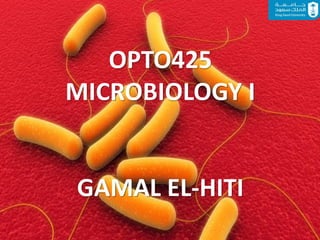
w10_-_opto425_lecture_09.pdf w10_-_opto425_lecture_09.pdf
- 3. Outcomes Measurement of the microbial growth The most common techniques used for microbial growth measurement Direct and indirect methods for microbial growth measurement The advantages of microbial growth measurement methods The disadvantages of microbial growth measurement methods Learning Outcomes
- 4. Measuring Microbial Growth Direct Methods of Measurement 1) Plate Count Method Most frequently used method of measuring bacterial populations. Inoculate plate with a sample of bacteria and count number of colonies. Assumptions Each colony originates from a single bacterial cell and no cell aggregates. Original inoculum is homogeneous.
- 5. Advantages of plate count method Measures viable cells. Disadvantages of plate count method It takes 24 hours or more for visible colonies to appear. It can be only used to count between 25 and 250 colonies with high accuracy. It requires to perform serial dilutions to get the appropriate concentration to give desirable numbers of colonies per plate. Measuring Microbial Growth
- 6. If the concentration of bacteria is too great, the colonies will grow into each other and the plate will be uncountable. Number of bacteria/mL = number of colonies on plate reciprocal of dilution of sample. e.g., if 32 colonies are on a plate of 1/10,000 dilution then what is the count? The count = 32 10,000 = 320,000/mL of sample. Measuring Microbial Growth
- 8. Types of Plate Count Technique A Pour Plate Method Introduce a 1.0 or 0.1 mL inoculum into an empty Petri dish. Add liquid nutrient medium and kept at 50 C. Gently mix, allow to solidify and incubate. Disadvantages of pour plate method Not useful for heat sensitive organisms. Colonies appear under agar surface. Measuring Microbial Growth
- 11. B Spread Plate Method Introduce a 0.1 mL inoculum onto the surface of Petri dish. Spread with a sterile glass rod. Advantages of spread plate method Colonies will be on surface and not exposed to melted agar. Measuring Microbial Growth
- 14. It is used to measure small quantities of bacteria. e.g. Fecal bacteria in a lake water. A large sample (100 mL or more) is filtered to retain bacteria. Direct Methods of Measurement 2) Filtration Measuring Microbial Growth
- 15. Bacteria are retained on the surface of a membrane filter. Bacteria was then transferred to a culture medium onto a Petri dish to grow. Incubate the bacteria under optimal conditions and count colonies. Measuring Microbial Growth
- 16. Direct Methods of Measurement 3) Most Probable Number (MPN) It is used mainly to measure bacteria that can not grow on solid medium. Dilute a sample repeatedly and inoculate several broth tubes for each dilution point. Count the number of positive tubes along with negative ones in each set. Measuring Microbial Growth
- 18. Before the tubes are inoculated, the chance is at least 95% that the confidence interval associated with the eventual result will enclose the actual concentration. Statistical Method Determines 95% probability that a bacterial population falls within a certain range. Measuring Microbial Growth
- 19. Direct Methods of Measurement 4) Direct Microscopic Count A specific volume (0.01 mL) of a bacterial suspension is placed on a microscope slide with a special grid. Stain is added to visualize bacteria. Cells are counted and multiplied by a factor to obtain concentration. Measuring Microbial Growth
- 21. Advantages of direct microscopic count No incubation time is required. It is a rapid, simple and easy method requiring minimum equipment. Disadvantages of direct microscopic count The method cannot distinguish between live and dead bacteria. Motile bacteria are difficult to count. Requires a high concentration of bacteria (10 million/mL). Measuring Microbial Growth
- 22. Measuring Microbial Growth Indirect Methods of Measurement 1) Turbidity As bacteria multiply in media, it becomes turbid. A spectrophotometer is used to determine the transmission percentage or absorbance of the media. Multiply by a factor to determine the concentration of bacteria. More light is absorbed when more cells are present.
- 24. Advantages of turbidity method No incubation time is required. Estimation of large numbers of bacteria in clear liquid media and broths. Disadvantages of turbidity method Cannot distinguish between live and dead bacterial cells. Requires a high concentration of bacteria not less than 107cells per mL (10 to 100 million cells/mL). Measuring Microbial Growth
- 25. Indirect Methods of Measurement 2) Metabolic Activity As bacteria multiply in media, they produce certain products, e.g. CO2 and acids. The quantity of such metabolic products can be measured. The method is relatively expensive. Measuring Microbial Growth
- 26. Indirect Methods of Measurement 3) Dry Weight Measurement of dry weight or wet weight of cells after centrifugation. Bacteria or fungi in liquid media are centrifuged. Resulting cell pellet is weighed. Measures total cell yield in cultures. Doesn’t distinguish live and dead cells. An E. coli cell has a dry mass of about 7.0 x 10-19 mg. Measuring Microbial Growth
- 27. List of Reagents and Instruments for the Measuring Microbial growth Flasks, graduated cylinder and filtration unit with vacuum pump. Centrifuge, oven up to 100 C, balance and spectrophotometer. Cell counting chamber and microscope. Petri dish, sterile pipets, sterile and bottles. Flask of culture, nutrient agar and sterile water. Measuring Microbial Growth
